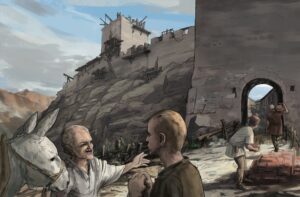- Home
- Individual tours
- Zähringen tour
Zähringen tour
| English text |
| Town, market, castle At the bottom is the town and its narrow streets and alleys, which are so tight, they would be barely passable on crowded market days. Many people lived in a small space, and there was constant noise and unpleasant smells. How different life was here at the castle: apart from the Hoftage, only the chatelain and a few servants lived within these imposing walls. Mice scurrying about, spiders weaving their webs. The grand halls are empty and tales of the castle ghost seem really quite convincing after all …
|
| Temporary residences The medieval lords travelled frequently. A castle like Burgdorf remained empty much of the time, with only the chatelain remaining to oversee a few servants. But when the lord took up temporary quarters again, the castle and the city came back to life. Hundreds of nobles with their entourages and horses would gather for several weeks. |
| To rule is to travel Presence is power In the Middle Ages, rulership was directly linked to a person. The feudal lord had to display his presence, or else his rule was seen as weak. The princes travelled through their territory, visited nobles and convents, organised festivals and tournaments, dispensed justice, arbitrated, advised, gave orders… When a prince arrived in a city, he would ideally stay in the castle. He was never alone, but always surrounded by a large court and many guests. A castle and its town had to be capable of springing into action overnight and providing shelter, food and entertainment for a large number of people and animals. 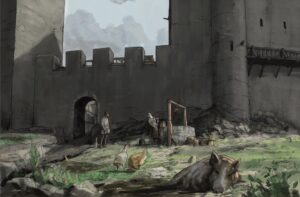 |
| A question of fashion The fortified castles Fortified Castles were the embodiment of chivalrous power, but they were a relatively short-lived trend, since almost all of them were built between 1000 and 1300. Many of the “medieval” castles today were founded in this period but only gradually came to look like they do today, and for the most part the most dramatic changes actually took place in modern times. |
| More a symbol than a bunker The many functions of a castle The function of castles can be easily identified at first glance: they are designed to withstand military attacks. But defence was only one function among others. First and foremost, castles were meant to show who had the most power. It was more important to impress than to actually be capable of defending oneself against enemies. Together with the cities that grew up around them, castles acted as political and economic centres. They served as residences for lords and their families as they travelled through their territory from castle to castle. And they were meeting places for the ruling elite to negotiate with each other and to hold celebrations. 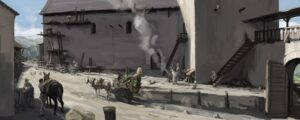 |
| The Great Hall The great hall of the castle could accommodate several hundred people. Count Berthold would use it as a gathering space when he stayed in Burgdorf. The grandest events were the court banquets of the Zähringen family: all the nobility were invited, the von Affoltern, the von Bubenberg, the von Worb, the von Wyl … the Zähringen family line consisted of sixty noble families. |
| Displays of power “Hoftage” (Court assemblies) For the courtly Hoftage, the great hall would be shown in all its splendour: with tapestries and carpets, flags and table decorations – all illuminated by hundreds of candles. During the Hoftage the Duke would dispense justice and hold public meetings, but above all, Hoftage were lavish celebrations with exquisite food, music, dances and entertainment. Hoftage were an integral part of feudal politics. Speeches were made, feats were praised, enemies were cursed, objectives were declared, victories were celebrated, guests were honoured, knights were adored… All this was a lot of work. The castle had few staff, so cooks, butchers, bakers, maids, valets, musicians, jugglers, etc. were recruited especially for the Hoftage. For personal service, guests would bring their own servants. 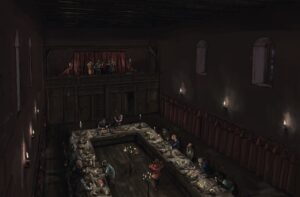 |
| Faith and Prayer In the Middle Ages, faith was a constant presence in all areas of life: culture, politics and economics were all shaped by Christianity. The afterlife was omnipresent – after death, you arrived in purgatory, where you waited until God decided on Judgement Day whether you would be going to Heaven or Hell. It was a sin to miss Sunday Mass. The burghers and peasants went with their families to worship in the parish church. The lords of the castle had their own chapel. 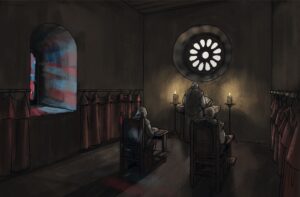 |
| Negotiating and celebrating Zähringen Castle had three state rooms, of which the Knights’ Hall was the smallest. Here the Duke met his closest allies to discuss, negotiate and agree on treaties. Celebrations were also held in the castle halls, where people would eat, drink and enjoy the songs of the troubadours … perhaps in summer the knight’s family would even sleep in this room. |
| The most important events in the history of the House of Zähringen and the House of Kyburg.
10th/11th C. : The Zähringer are counts in the Breisgau and Thurgau. In the year 999 they founded their first trading market in Villingen, north of Schaffhausen. Villingen becomes the centre of the Zähringen estate. |
| 1218 : Berthold V dies with no issue. The Counts of Urach inherit the Zähringer territory to the north of the Rhine, the Counts of Kyburg inherit the territory to the south. Burgdorf should go to Clémence, Berthold’s widow, but the Kyburg family occupy the castle. Berthold’s brother- in-law, Egon d’Urach, helps them by imprisoning Clémence. 1224 : Hartmann IV of Kyburg becomes Count of Burgdorf. 1246-1250 : Division of the Kyburg territory. Count Hartmann V is granted the western part and makes Burgdorf his residence. 1263 : Hartmann V dies. His widow, Elisabeth de Chalon, takes power. Count Rudolf of Hapsburg becomes the guardian of Hartmann and Elizabeth’s underage daughter, Anna. 1273 : Anna marries Eberhard de Hapsburg- Laufenburg. The debt-ridden couple establish the new line of the Counts of Kyburg-Burgdorf. 14th C. : The counts oscillate between Hapsburg and Bern. 1383-1384 : Count Rudolf II of Burgdorf starts a war with Bern for supremacy over the County of Burgundy. After his defeat, Rudolf II is forced to sell the cities of Burgdorf and Thun to Bern. 1417 :The last Count of Kyburg-Burgdorf, Berchtold I, dies in Wangen an der Aare. |
